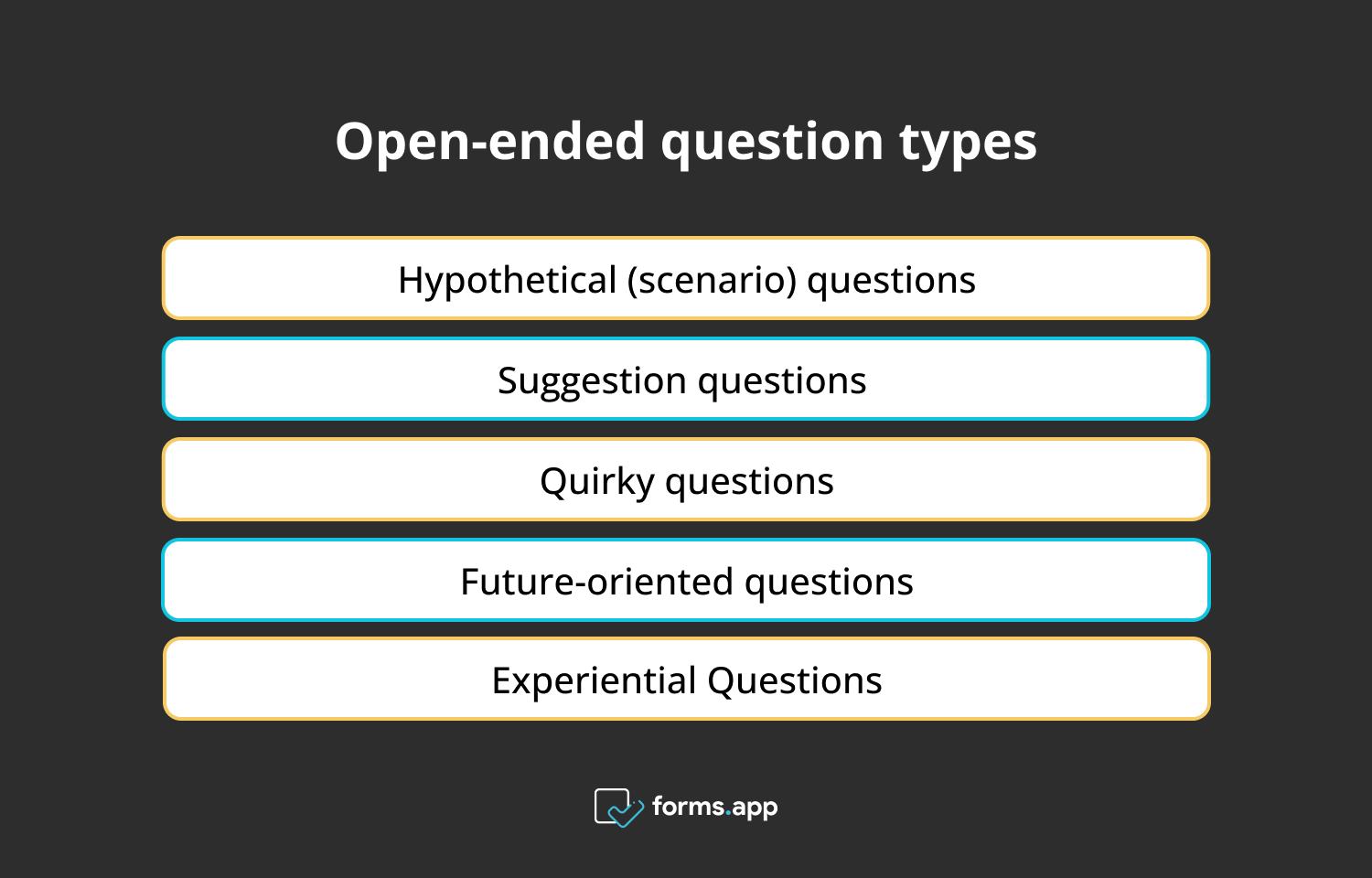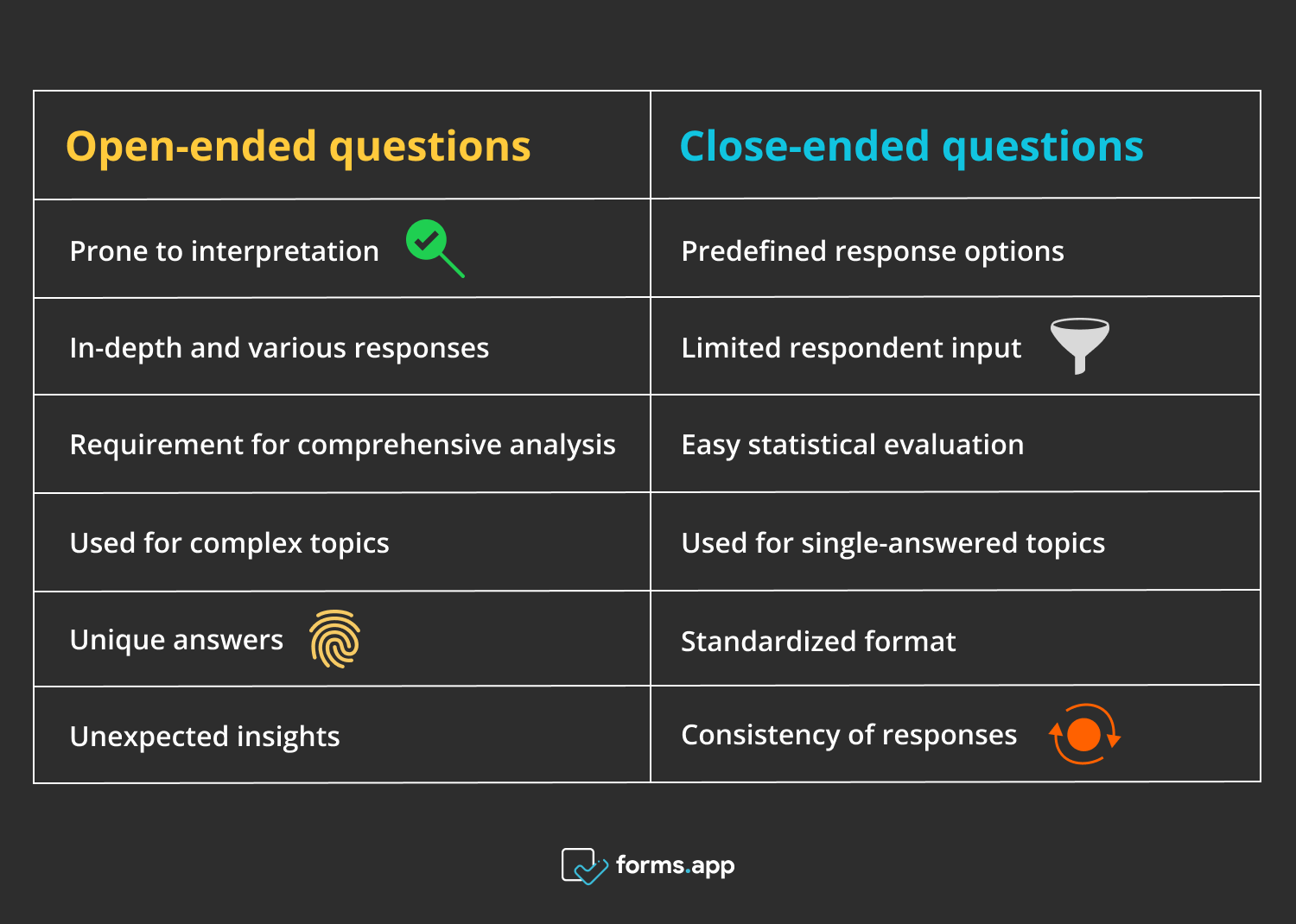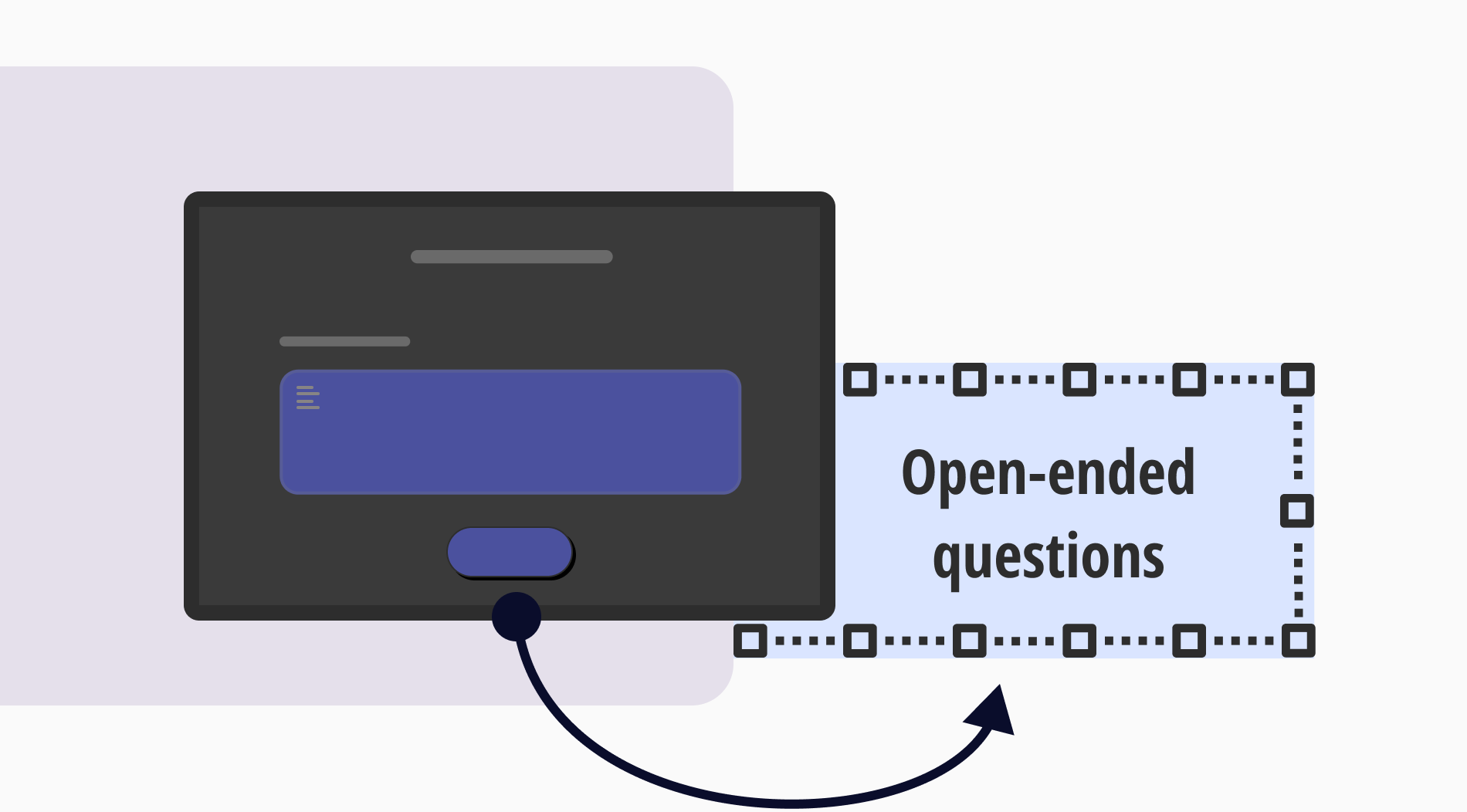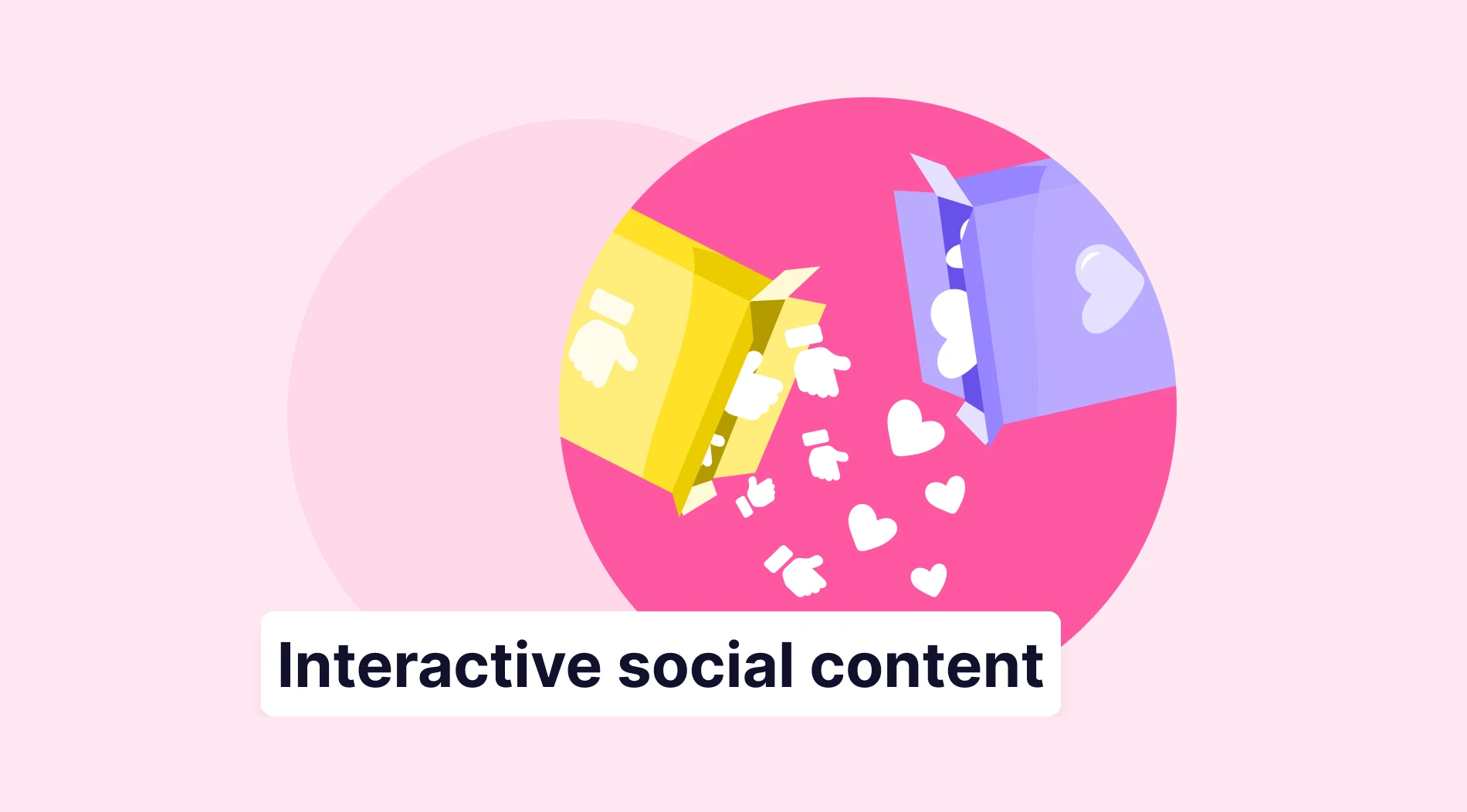Open-ended questions are powerful tools for gaining deeper insights into a specific topic. Open-ended questions, unlike closed-ended questions, which frequently elicit simple or brief replies, encourage deliberate and extensive responses. This can lead to an exchange of ideas between the survey creator and the survey taker.
Open-ended questions encourage critical thinking and creativity as well. They encourage people to think from different perspectives. By embracing the potential of open-ended questioning, people can obtain precious insights into relevant matters. These questions push the envelope of conventional knowledge and stoke the flame of creativity.
By reading this guide article for open-ended questions, you can expect to discover various tips for open-ended questions. Additionally, this article will likely offer practical examples to illustrate the effectiveness of them.
What is an open-ended question?
Open-ended questions are thought-provoking questions to be answered in detail. These types of questions allow respondents to answer in the scope of their complete knowledge. Whether used in research, surveys, or interviews, open-ended questions provide a chance for discovery.
Survey creators benefit greatly from open-ended questions. Also, survey takers are more likely to feel valued when they are given the option to express their ideas in their own words. By allowing respondents to share their thoughts, experiences, and opinions with good open-ended questions, survey designers can create a more inclusive survey experience.
Types of open-ended questions
When seeking comprehensive and meaningful information, open-ended questions play a crucial role. In this section, we will explore diverse types of open-ended question types applicable across various contexts. By comprehending the distinct types of open-ended questions, you can customize your approach to extract the desired insights and responses from participants.

Open-ended question types
Every type of open-ended question has a specific function. Some are designed for hypothetical situations that stimulate critical thinking, while others are suggestion questions that inspire creativity, build rapport, and foster an engaging atmosphere.
- Hypothetical (scenario) questions: Hypothetical questions, also called as scenario questions provide the survey taker a fictional circumstance or scenario to ponder probable outcomes, viewpoints, or actions.
- Suggestion questions: These questions are designed to elicit creative and innovative responses. In suggestion questions, survey takers can express their genuine ideas freely.
- Quirky questions: Quirky open-ended questions can be used in icebreaker activities, team-building exercises, or just for fun! These types of questions improve the sense of humor.
- Future-oriented questions: Respondents speculate about future developments or possibilities when answering future-oriented questions. These questions encourage forward-thinking.
- Experiential Questions: These types of questions invite participants to share their personal experiences or stories in detail related to a particular theme or subject.
Why and when do you need an open-ended question?
When you want to go further into a subject and learn more about it in depth, open-ended questions are essential. In circumstances when you want to collect extensive qualitative data, you might need open-ended questions. By encouraging participants to think broadly, these questions generate fruitful answers.
In general, open-ended questions are necessary when you want to go deeply into a subject, collect qualitative data and support creativity. We can say that open-ended questions are particularly useful in this regard. To sum up, open-ended questions offer versatile opportunities for usage across various contexts and purposes. Open-ended questions for surveys facilitate as a valuable tool in numerous fields.
35+ Open-ended question examples for your next form or survey
As the forms.app team, we are aware of the importance of gathering valuable data. In this section, we compiled 35+ open-ended questions in research examples to help you achieve this. You can improve your experiences and understanding of your target audience by getting inspired by these sample questions.
forms.app offers different question formats, such as long text, short text, and masked texts. You can utilize these question types to get data in the way you need.
Open-ended questions for research
Research open-ended questions are very useful in qualitative research approaches like focus groups and interviews. By facilitating a deeper exploration of the research topic, these questions help researchers probe further.
1. Can you explain any contradictions or inconsistencies you observed within the research topic? (Long text)
2. In your opinion, what are the long-term effects of the research project? (Long text)
3. Can you suggest areas of further research or exploration? (Short text)
4. What do you perceive as the main challenge of the research? (Short text)
5. How do you think cultural and environmental factors influence the study? (Long text)
6. Did the language of the research report affect your understanding? Why? (Long text)
7. What are the approaches or strategies employed during the research? (Short text)
Open-ended questions for sales
In the field of sales, open-ended questions are crafted to encourage customers to express their opinions. In this way, sales professionals gain access to valuable information and identify specific troubles.
8. What aspect of our product or service's potential excites you? (Short text)
9. Can you provide insights into our internal sales initiatives? (Long text)
10. What types of sales strategies do you want to see in the next year? (Long text)
11. What, in your opinion, is the most efficient means of fostering enduring relationships with customers? (Short text)
12. How do you measure and track your sales performance? (Long text)
13. Do you think social media affects your sales? If so, can you please indicate whether this effect is positive or negative? (Short text)
14. How do you evaluate the return on investment (ROI) for your work? (Long text)
Open-ended questions for customer surveys
Open-ended questions for customer surveys aim at nuanced customer feedback. In this way, companies can make informed decisions to enhance the customer experience and drive business growth.
15. Do you appreciate the communication within our company? Why? (Long text)
16. How would you recommend our product/service to others, and what specific value would you emphasize? (Long text)
17. If our product/service had a personality, how would you describe it? (Long text)
18. If you could change one thing about our product/service, what would it be? And why? (Long text)
19. Can you provide an example of a situation where our customer support team resolved a problem? (Short text)
20. What additional features or functionalities would you like to see in our product? (Short text)
21. Can you describe the relationship or connection you feel with our brand? (Long text)
Open-ended questions for employee surveys
Open-ended questions are important in capturing employee feedback. These types of questions are vital to take action to create a more positive and engaging work environment.
22. Can you describe a time when you felt your ideas or opinions were valued and included in the decision making process? (Long text)
23. How would you describe the company culture? (Long text)
24. Do you think your performance is effective in the company? Why? (Short text)
25. Between 1-10, how would you rate the level of trust and transparency between management and employees? (Short text/Masked question type)
26. Can you share an example of a time when you felt genuinely recognized or appreciated for your work? (Long text)
27. If you could implement one change to enhance teamwork, what would it be? (Short text)
28. What factors contribute to your motivation? (Long text)
You can add a comment field to multiple-choice questions; thus, these questions function as open-ended questions.
Open-ended questions for friends
Open-ended questions can help you and your friends connect in meaningful ways and gain a deeper knowledge of one another. The introductory questions below are an excellent way to start if you want to strengthen your connection.
29. What is your favorite way to unwind and relax after a long day? (Short text)
30. If you could trade lives with any fictional character for a day, who would it be and why? (Long text)
31. What is your biggest fear, and how do you overcome it? (Long text)
32. What is your favorite ice cream topping? (Short text)
33. If you could have a humorous sound effect follow you wherever you go, what sound effect would it be, and when would it play? (Long text)
34. What is the silliest nickname you've ever had or given to someone else? (Short text)
35. What is one valuable lesson you've learned from your friendships? (Short text)
The masked text is intended to aid you if you want to collect responses in a particular way.
How to ask open-ended questions on forms.app
Utilizing the capabilities and adaptability of forms.app, you can create forms that invite thorough and insightful input from your audience. By incorporating open-ended questions, you will enable your survey takers to reveal their detailed thoughts. In this section, we will provide guidance on how you can easily create forms with open-ended questions in forms.app.
1 - Sign in to your forms.app account or create a new account in case you don't have an account already.
2 - Choose a template or start from scratch.
3 - Select from open-ended question types such as long text and short text.
4 - Customize the question by clicking on the added field.
5 - Make sure the open-ended questions on your form are working properly by testing them using the preview option.
6 - Make your form's appearance and layout specific to your company's identity or the subject of your survey.
7 - Publish and distribute your form with your audience whenever you are satisfied with it via a variety of means, including email, social media, and embedding it on your website.
Encourage them to tell stories by posing questions that are compelling. Respondents will describe their encounters in depth.
Open-ended questions vs. close-ended questions
Even though both open-ended and close-ended questions can be used in surveys for analysis, it is really important to differentiate the two types. In order to improve your surveys in this respect, we have compared the two types in detail in the table below.

The comparison of open-ended and close-ended questions
Key points to take away
The power of open-ended questions lies in their ability to go beyond restricted answers. With the help of open-ended questions, people will unlock richer insights regarding the topic.
- Give survey takers sufficient time: It's vital to allow survey takers enough time to think and respond when conducting surveys, including open-ended questions so that they can provide meaningful answers.
- Demonstrate open-mindedness: Avoid biased notions and provide assurance that there will be no misunderstandings and that the questionnaire will be handled objectively.
- Begin questions with "how," "what," and "why”: These questions will result in descriptive responses and prompt survey takers to elaborate.
- Follow up on the answers: Following up on respondents' answers demonstrates how much value you put on their ideas.
- Use symbolic representation: Utilizing metaphors, symbols, or imagery in your questions allows you to attract participants' interest and elicit more intense feelings or profound insights.
To promote survey participation and boost response rates, think about providing incentives or awards.
In conclusion, open-ended questions are crucial when attempting to investigate a subject, collect substantial qualitative data, and encourage participants to think critically. They are a valuable resource for an in-depth comprehension of a subject or phenomenon and for developing complete perspectives.
Open-ended questions can be a valuable tool for researchers, companies, and organizations to build unique perspectives and a comprehensive understanding of complicated events. Start learning more about forms.app's features today to realize the full potential of open-ended survey questions!
Ayşegül is a content writer at forms.app and a full-time translation project manager. She enjoys scrapbooking, reading, and traveling. With expertise in survey questions and survey types, she brings a versatile skill set to her endeavors.



